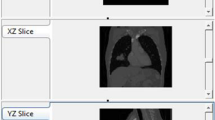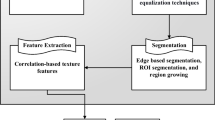Abstract
Nowadays, lung cancer has arisen as one of the major causes of death and subsequently making its detection immensely difficult. In this research article which consists of five steps framework, three different methods were developed for automatic detection and classification of lung tumor in CT (Computed Tomography) images. The initial step is an image acquisition; here, the input images are collected from public and in-house clinical lung cancer image. The next step image enhancement is performed using WFUM (Weiner Filter with Unsharp masking) enhancement technique which can eradicate the noise discern in the input images. In the subsequent step, the HRWBM (Hierarchical Random Walker with Bayes Model) segmentation algorithm is implemented on an enhanced image sequence for lung tumor region prediction and then the features are extracted using GLCM (Gray Level Co-occurrence Matrix). Ultimately, the lung cancer images (Public LIDC database) are classified by utilizing an HRWBM with SVM (Support Vector Machine) classification where the accuracy is 77.8%; in HRWBM with FFNN (Feed-Forward Neural Network) classification, the accuracy is 93.3%; in HRWBM with DRNN (Deep Recurrent Neural Network) classification, the accuracy is 97.3%. For in-house clinical dataset, the classification result is HRWBM with SVM classification where the accuracy is 84%; in HRWBM with FFNN classification, the accuracy is 90%; in HRWBM with DRNN classification, the accuracy is 94.7% predicted. The classification result reveals that among the three algorithms, the third method improves the accurate identification of lung cancer.










Similar content being viewed by others
Availability of data and materials
Not Applicable.
References
Kiaei, A.A., Khotanlou, H.: Segmentation of medical images using mean value guided contour. Med. Image Anal. 40, 111–132 (2017)
Albert Jerome, S., Vijila Rani, K., Mithra, K.S., Eugine Prince, M.: Watershed segmentation with CAFIS and RCNN classification for pulmonary nodule detection. IETE J. Res. (2021). https://doi.org/10.1080/03772063.2018.1557086
Ukil, S., Reinhardt, J.M.: Anatomy-guided lung lobe segmentation in X-ray CT images. IEEE Trans. Med. Imaging 28(2), 202–214 (2009)
Vijila Rani, K., Thinkal Dayana, C., Sujatha Therese, P., Eugine Prince, M.: Triple novelty block detection and classification approach for lung tumor analysis. Int. J. Imaging Syst. Technol. (2020). https://doi.org/10.1002/ima.22509
Nageswaran, S., Arunkumar, G., Bisht, A.K., Mewada, S., Swarup Kumar, J.N.V.R., Jawarneh, M., Asenso, E.: Lung cancer classification and prediction using machine learning and image processing. BioMed Res. Int. 2022, 8 (2022)
Jassim, M.M., Jaber, M.M.: Systematic review for lung cancer detection and lung nodule classification: taxonomy, challenges, and recommendation future works. J. Intell. Syst. 31(1), 944–964 (2022)
Xie, H., Pierce, L.E., Ulaby, F.T.: SAR speckle reduction using wavelet denoising and Markov random field modeling. IEEE Trans. Geosci. Remote Sens. 40(10), 2196–2212 (2002)
Kostis, W.J., Reeves, A.P., Yankelevitz, D.F., Henschke, C.I.: Three-dimensional segmentation and growth-rate estimation of small pulmonary nodules in helical CT images. IEEE Trans. Med. Imaging 22(10), 1259–1274 (2003)
Pantanowitz, L.: Digital images and the future of digital pathology. J. Pathol. Inform. 1, 1–15 (2010)
Alam, B., Mohammad, A.: Detection of lung cancer from CT image using image processing and neural network. In: International Conference on Electrical Engineering and Information Communication Technology (ICEEICT), pp. 1–6 (2015)
Khatami, A., Nahavandi, S., Khosravi, A., Salaken, SM., Hosen, MA.: Lung cancer classification using deep learned features on low population dataset. In: IEEE 30th Canadian Conference on Electrical and Computer Engineering (CCECE), pp. 1–5 (2017)
Hamada, R., Belhaouri, B., Sulaiman, S.: A computer aided diagnosis system for lung cancer based on statistical and machine learning techniques. JCP 9(2), 425–431 (2014)
Patil & Aniketbombale: Segmentation of lung nodule in CT data using K-means clustering. Int. J. Electr. Electron. Data Commun. 5, 36–39 (2017)
Keziah & Haseena: Lung cancer detection using SVM classifier and MFPCM Segmentation. Int. Res. J. Eng. Technol. 5, 1–7 (2018)
Vijila Rani, K., Albert Jerome, S., Josephin Shermila, P., Shoba, L.K., Eugine Prince, M.: Automatic segmentation of lung tumor from X-ray images using advance novel semantic approach. IETE J. Res. (2021). https://doi.org/10.1080/03772063.2021.1959419
Malik, B., Singh, PJ., Singh, PBV., Naresh, P.: Lung cancer detection at initial stage by using image processing and classification techniques. Int. Res. J. Eng. Technol. 3(11), 781–786 (2016)
Paul, R., Hawkins, HS., Hall, OL., Goldgof, BD.,Gillies, JR.: Combining deep neural network and traditional image features to improve survival predication accuracy for lung cancer patients from diagnostic CT. IEEE (2016)
Wafaa, M., Amr: Lung cancer detection and classification with 3D convolutional neural network. Int. J. Adv. Comput. Sci. Appl. 8, 1–8 (2018)
Majdi, M.S., Salman, K.N., Morris, M.F., Merchant, N.C., Rodriguez, J.J.: Deep learning classification of chest X-Ray images. In: 2020 IEEE Southwest Symposium on Image Analysis and Interpretation, SSIAI 2020 – Proceedings, pp. 116–119 (2020)
Zubair, M.: Detection of lung nodules in chest radiographs using wiener filter and D-CNN Model. TechRxiv (2021). Preprint. https://doi.org/10.36227/techrxiv.14716203.v1
Vijila Rani, K., Joseph Jawhar, S.: Emerging trends in lung cancer detection scheme- a review. Int. J. Res. Anal. Rev. 5(3), 530–542 (2018)
Shimazaki, A., Ueda, D., Choppin, A.: Deep learning-based algorithm for lung cancer detection on chest radiographs using the segmentation method. Sci Rep 12, 727 (2022)
https://wiki.cancerimagingarchive.net/display/Public/LIDC-IDRI.
Rani, K.V., Joseph Jawhar, S.: Novel technology for lung tumor detection using nanoimage. IETE J. Res. 67(5), 699–713 (2021)
Sheela Shiney, T.S., Jemila Rose, R.: Deep auto encoder based extreme learning system for automatic segmentation of cervical cells. IETE J. Res. 1–21 (2021)
Grady, L.: Random walks for image segmentation. IEEE Trans. Pattern Anal. Mach. Intell. 28(11), 1768–1783 (2006)
Dong, H., Zeng, X., Lin, L., Hu, H., Han, X., Naghedolfeizi, M., Aberra, D., Chen, Y.-W.: An improved random walker with bayes model for volumetric medical image segmentation. J. Healthc. Eng. 2017, 11 (2017)
Vijila Rani, K., Joseph Jawhar, S.: Lung lesion classification scheme using optimization techniques and hybrid (KNN-SVM) classifier. IETE J. Res. 68(2), 1485–1499 (2022)
Vijila Rani, K., Joseph Jawhar, S.: Automatic segmentation and classification of lung tumor using advance sequential minimal optimization techniques. IET-Image Process. (2020). https://doi.org/10.1049/iet-ipr.2020.0407
Chellan, T.D., Chellappan, A.K.: Novel computer-aided diagnosis of lung cancer using bag of visual words to achieve high accuracy rates. J. Eng. 2018(12), 1941–1946 (2018)
Suarez-Cuenca, J., Tahoces, P., Souto, M., Lado, M., Remy- Jardin, M., Remy, J., Jose Vidal, J.: Application of the iris filter for automatic detection of pulmonary nodules on computed tomography images. Comput. Biol. Med. 39, 921–933 (2009)
Ricciardi, S., Tomao, S., de Marinis, F.: Efficacy and safety of erlotinib in the treatment of metastatic non-small-cell lung cancer. Lung Cancer Target Ther. 2, 1–9 (2011)
Cascio, D., Magro, R., Fauci, F., Lacomi, M., Raso, G.: Automatic detection of lung nodules in CT datasets based on stable 3D mass spring models. Comput. Biol. Med. 42(11), 1098–109 (2012)
Acknowledgements
The authors are thankful for the National Cancer Institute Kanyakumari for providing the lung cancer scans database and we want to thank the anonymous reviewers for their help with this article improvement.
Funding
None.
Author information
Authors and Affiliations
Contributions
SLS: Roles: Conceptualization, Methodology, Validation, Visualization, Writing—original draft, Writing-Reviewer Comments Correction, Proof reading and Visualization. TABR: Roles: Visualization, Data Correction, Resources, and Validation Reviewer Comments Correction and Editing.
Corresponding author
Ethics declarations
Conflict of interest
The author declares that they have no conflict of interest.
Ethical approval
This study has not been supported by any industrial company and does not serve to promote any commercial product. Anonymized publicly available databases were used in the conducted experiments.
Additional information
Publisher's Note
Springer Nature remains neutral with regard to jurisdictional claims in published maps and institutional affiliations.
Rights and permissions
Springer Nature or its licensor (e.g. a society or other partner) holds exclusive rights to this article under a publishing agreement with the author(s) or other rightsholder(s); author self-archiving of the accepted manuscript version of this article is solely governed by the terms of such publishing agreement and applicable law.
About this article
Cite this article
Soniya, S.L., Raj, T.A.B. Lung tumor analysis using a thrice novelty block classification approach. SIViP 17, 3027–3034 (2023). https://doi.org/10.1007/s11760-023-02523-0
Received:
Revised:
Accepted:
Published:
Issue Date:
DOI: https://doi.org/10.1007/s11760-023-02523-0




